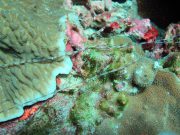Diving with Bristle Worms
Lanta Marine Life | Polychaeta
The Polychaeta are a huge group of marine worms, also known as the bristle worms or polychaetes. They are among the most common marine organisms.
Polychaetes are multi-segmented worms living in all environments in the world's oceans. Most polychaete body segments bear a pair of parapodia (flat, lobelike outgrowths) with a dense cluster of tiny bristles and hooks called chaetae. The name polychaete actually means 'many bristles'.
Polychaetes are divided informally into two groups; the errantia, or free-moving forms, and sedentaria, or tube-dwelling forms which are normally in a fixed location (imobile).
Diving with Bristle Worms around Koh Lanta
Scuba Diving & Snorkel Trips
If you'd love a chance to spot Bristle Worms on one of our daily high season diving trips from Koh Lanta then send us an email to info@diveandrelax.com.
Join our high season speedboat dive trips to some of Thailand's best dive sites and enjoy small groups, short journey times, with a focus on great personal service, safety and fun.
Not yet a certified diver? Learn to Scuba Dive on Koh Lanta with the 3 day SSI Open Water Diver course.
Book online to save 10% on dive trips and scuba courses on Koh Lanta.
Find Out More
Indo-Pacific Marine Life Guides
- Allen, G., Steene, R., Humann, P., DeLoach, N. (2003) Reef Fish Identification, Tropical Pacific. Jacksonville, FL., USA: New World Publications, Inc., ISBN 1-878348-36-1.
- Humann, P., DeLoach, N., (2010) Reef Creature Identification, Tropical Pacific. Jacksonville, FL., USA: New World Publications Inc., ISBN 978-1-878348-44-9
- Debelius, H. (2013) Indian Ocean Reef Guide. Frankfurt, Germany: IKAN - Unterwasserarchiv, ISBN 978-3-939767-52-7.
- Debelius, H. (2004) Nudibranchs and Sea Snails, Indo-Pacific Field Guide. Frankfurt, Germany: IKAN - Unterwasserarchiv, ISBN 3-925919-51-1
- Erhardt, H., Knop, D. (2015) Corals Indo-Pacific Field Guide. Frankfurt, Germany: IKAN - Unterwasserarchiv, ISBN 3-925919-69-4.
- Veron J.E.N., Stafford-Smith M.G., Turak E. and DeVantier L.M. (2016). Corals of the World


